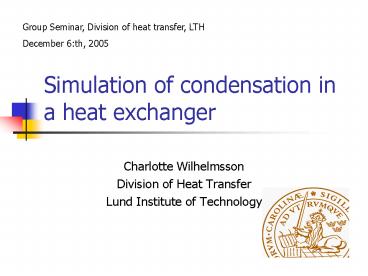Simulation of condensation in a heat exchanger
1 / 20
Title:
Simulation of condensation in a heat exchanger
Description:
Simulation of condensation in a heat exchanger –
Number of Views:166
Avg rating:3.0/5.0
Title: Simulation of condensation in a heat exchanger
1
Simulation of condensation in a heat exchanger
Group Seminar, Division of heat transfer,
LTH December 6th, 2005
- Charlotte Wilhelmsson
- Division of Heat Transfer
- Lund Institute of Technology
2
Outline
- Project description
- Background
- Methods
- Equations
- Future
3
Project Description
- Project Title
- Simulation of condensation in a heat exchanger
- Background
- It is interesting to conduct some numerical work
to gain some insight for this process, although
may not fully predict it. - Project is mainly sponsored by STEM, but in
cooperation with Alfa Laval.
4
Plate heat exchanger
5
Introduction
- The application of PHEs in process industries
have been significantly enlarged, due to - Compactness
- Effectiveness
- Cost competitiveness
- Traditional PHE are plate-and-frame heat
exchanger - Temperature limit 160 ºC
- Pressure limit 25 bar
6
Condensation
- Involves a phase change
- Saturated vapour such a steam comes in
contact with a solid whose surface temperature is
below the saturation temperature. - Normally when vapour condensates on a surface, a
film condensate is formed on the surface and
flows over the surface by the action of gravity.
7
Methods
- Possible methods
- Pure CFD
- Simplified numerical model
- Analytical solution
8
Original equationsCondensate film
9
Original equationsVapour flow
10
New coordinates
- Liquid phase
- Vapour phase
11
Liquid layer
1.
2.
3.
12
Vapour layer
1.
2.
13
Boundary conditions
- TV TS
- At the wall
- UL0
- VL0
- TLTW
- At the liquid vapour interface
- UL UV
- ?LVL ?VUV
14
What I have been doning since August
- Start to use the CALC-code for my project
- Teaching the course Thermodynamics and Fluid
dynamics - Styding the course Convective boiling and
condensation
15
The CALC-code
- Finite volume computer code
- For prediction of mass, heat and momentum
transfer - Utilizes a general non-orthogonal boundary fitted
coordinate system - Steady/unsteady, three-dimensional,
turbulent/laminar recirkulating flows
16
My case
- Change from horizontal to vertical
- Implement data for water, hydrogen and air
- Implement two-phase flow and phase-change
17
U-velocity
18
Temperature
19
Future work
- Implement condensation in CALC-code
20
- Thank you very much































